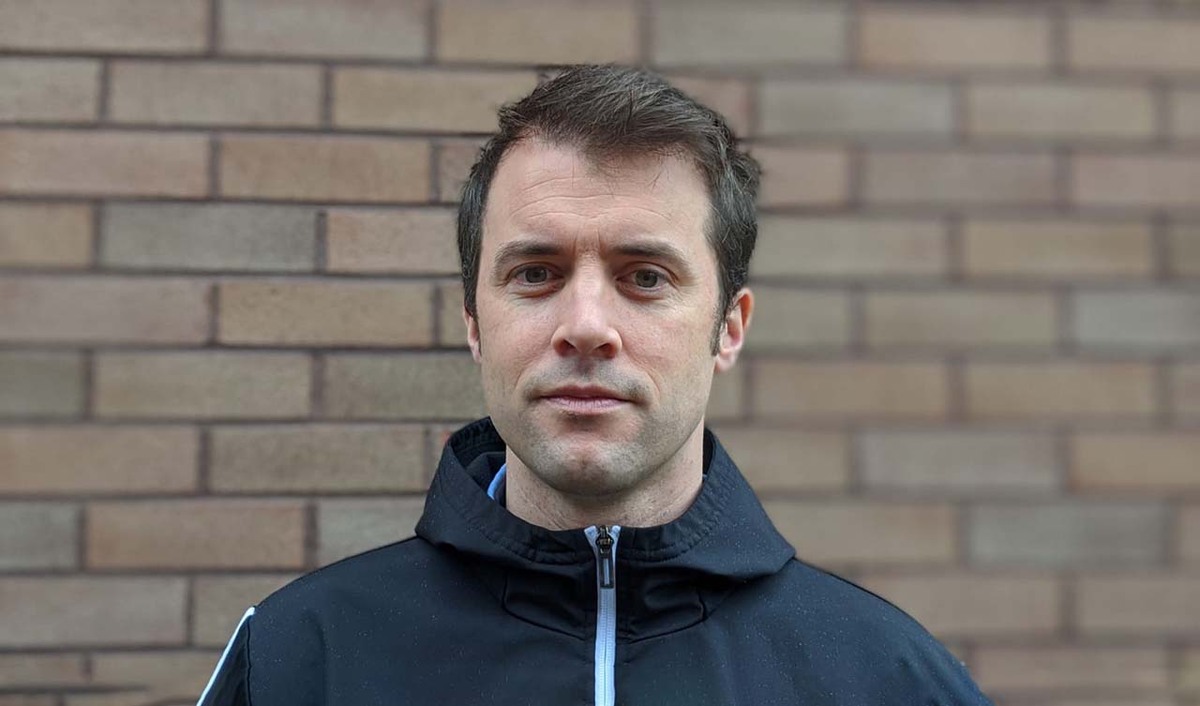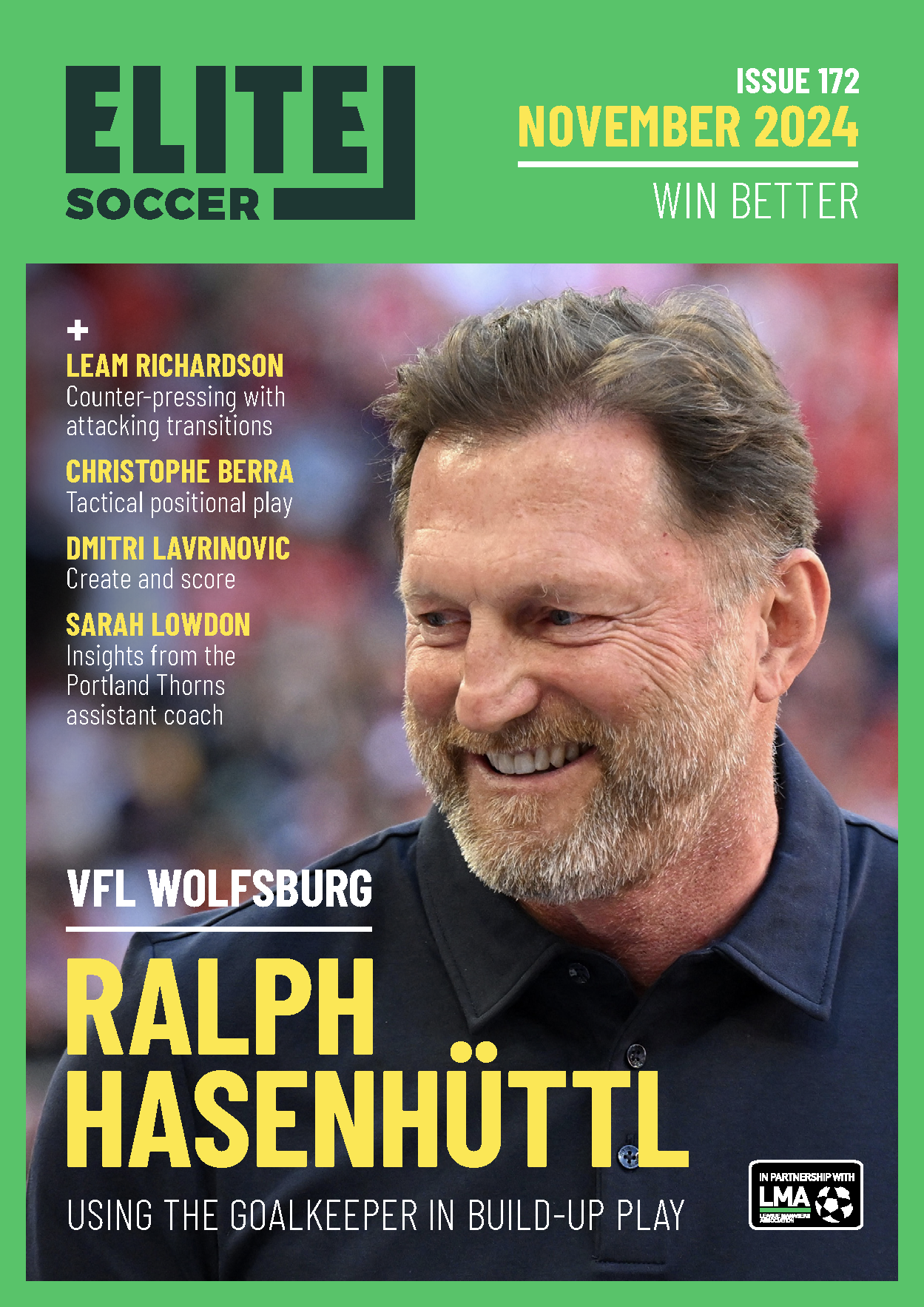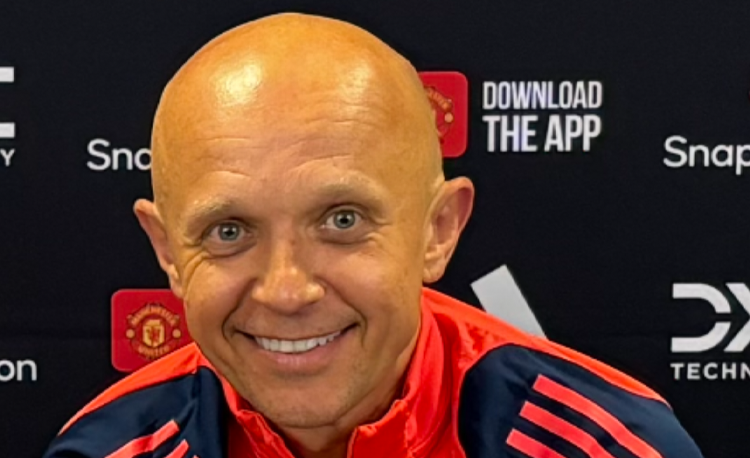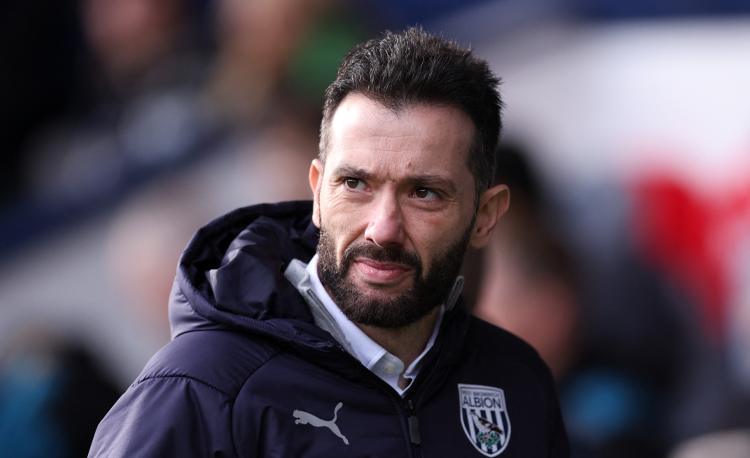You are viewing 1 of your 1 free articles
Transition principles
| Area | Up to three quarters of a pitch |
| Equipment | Balls, bibs, cones, 4 goals |
| No. of Players | 16 players + 4 goalkeepers |
| Session Time | Directional 2v2: 15mins, Four goal transition: 15mins, 9v9 game: 15mins |
I use this session to make our players fully understand our transition principles – both the transition from attack to defence and the transition from defence to attack.
We need to be hard to beat and by emphasising and improving our transition to defence, it will make us harder to score against and help us to attack confidently and bravely, knowing that we can trust our players in the transition to defence. As this is perfected and improved, our transition to defence will allow us to win the ball back quickly and help us to score with our transition to attack.
I love this session as it helps us work on both aspects of transition by recreating the real chaos, stresses and excitement of a game. Players also enjoy this session as it recreates the challenge and exertions of a match. As a result, they will guide, encourage and excitedly critique each other when we run it. Ultimately, the session allows the team to develop cohesion.
This session is crucial during pre-season when attempting to teach our principles of play. It is also helpful as a reactive session during the season when the transition to defence and/or attack needs to be revised or improved upon based on recent performances.
It is also beneficial as a proactive session if we feel that our upcoming opponents are either very strong or very weak on one of the transition elements.
DIRECTIONAL 2v2
We set up in a playing area of 50x45 yards, with a goal and a goalkeeper at each end and four cones set up in the centre of the pitch as shown. We’re using 16 outfield players split into two teams of eight. Each team is split into two groups of four, with the first player in each group active and the remaining players waiting on either side of the pitch for their turn.
On the coach’s call the first two active players from each team leave their starting points on each side of the pitch and sprint around the nearest cone. The coach then feeds a ball into the centre of the playing area, either directly to a player, as shown [1a], or into space to be won.
1a
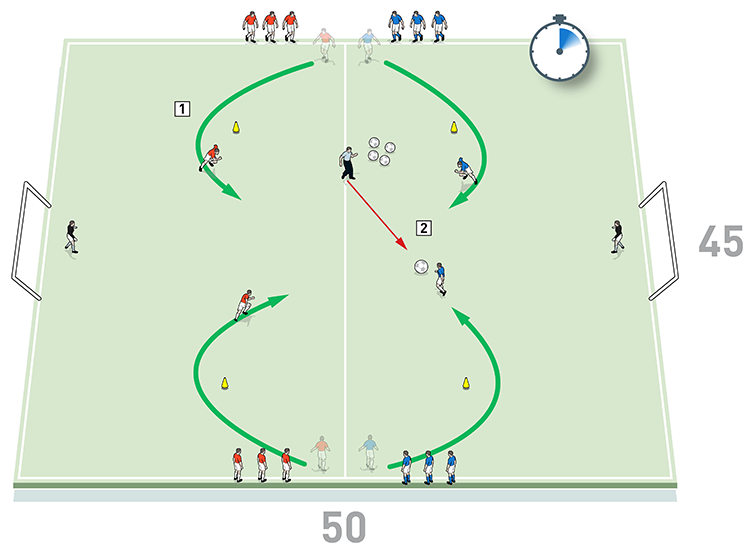
2. The coach feeds a ball into the centre of the playing area, either directly to a player or into space to be won
The players contest a 2v2 directional game and they have just 15 seconds to score in the goal at the end they are attacking, as shown [1b]. Teams get one point for a goal scored from initial possession and two points for a goal scored when in transition after winning the ball from the opposition.
1b

2. Teams get one point for a goal scored from initial possession and two points for a goal scored when in transition if they win the ball
Goalkeepers are encouraged to collect the ball and play out quickly to make the transition to attack if they have the opportunity.
When the 15 seconds is up, players join the back of their group and the next players go on the coach’s call.
We can progress this activity by increasing the numbers to 3v3 and then 4v4. We can also vary the starting points of each team so that the players are challenged by different transition situations.
FOUR GOAL TRANSITION
We set up on half a pitch with four goals and four goalkeepers. The goals are positioned on each side and at each end of the playing area. A different coloured bib is tied to the goalpost of each goal to identify and differentiate between each individual goal.
We’re using 16 outfield players split into two teams of eight. The coach starts play by passing to one of the teams and calling out a colour to indicate which of the goals should be attacked, as shown [2a].
2a
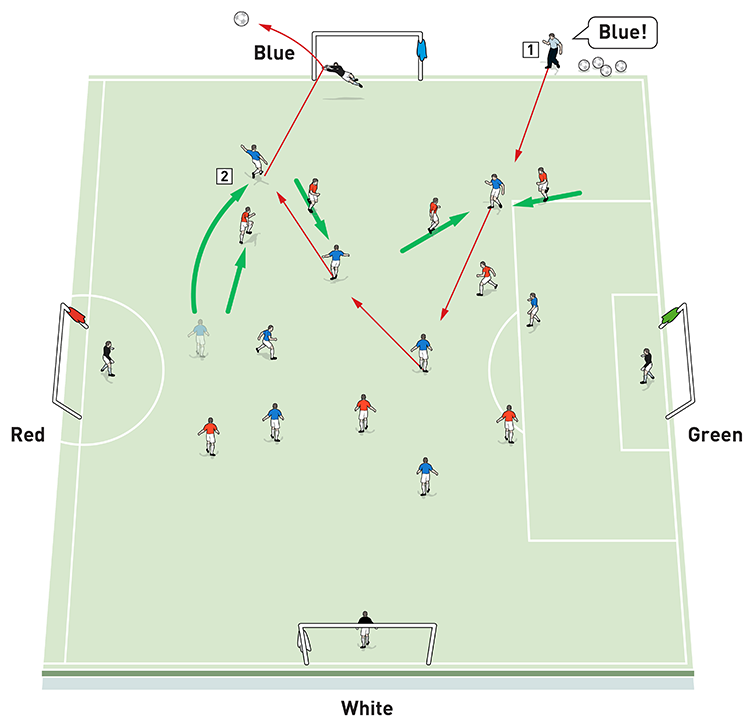
2. The two teams contest an 8v8 with the possession team trying to score in the goal selected by the coach
The two teams contest an 8v8, with the possession team trying to score in the goal selected by the coach. However, if the defending team wins possession, at the moment of transition the coach calls out the colour of a different goal and each team needs to adjust quickly and transition appropriately, as shown [2b]. This can be challenging as players may find themselves either in congested areas or in space, depending on the selection of goal. They may struggle to identify the new target and team mates needs to communicate this quickly to the player on the ball.
2b
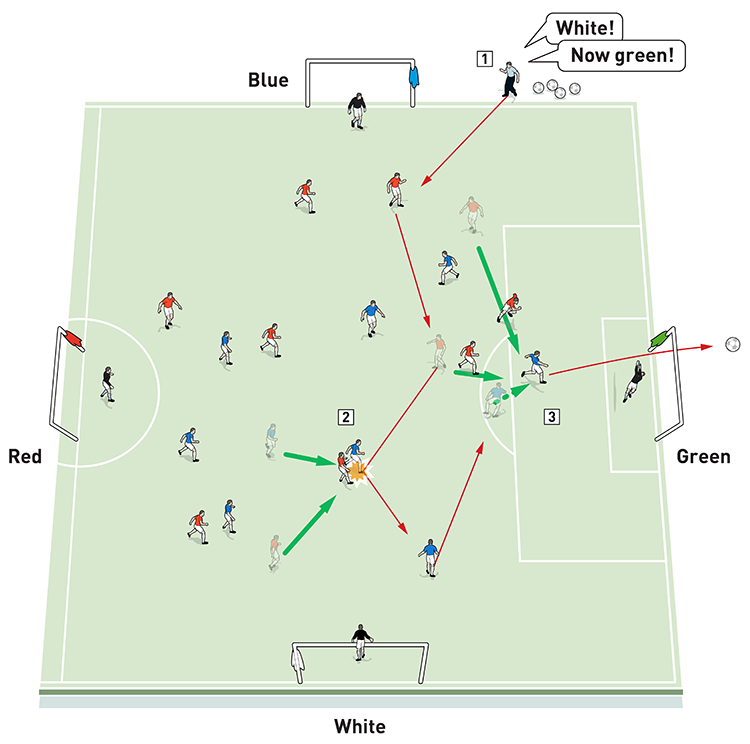
2. If the defending team wins possession, at the moment of transition the coach calls out the colour of a different goal
3. Each team needs to adjust and transition appropriately, with the new possession team attacking the new goal selected by the coach
It can be a hectic game but players love the nature of it and the guarantee of goalmouth action.
9v9 GAME
We set up on a normal pitch between the goal line at one end and the 18-yard line at the other end. We position a goal and a goalkeeper at each end. We’re using 16 outfield players split into two teams of eight plus keepers.
We play a normal 15-minute game, as shown [3], emphasising the transition principles the players have already explored. The aim is to consolidate what the players have learnt and improve the team’s transitions from defence to attack and from attack to defence.
3
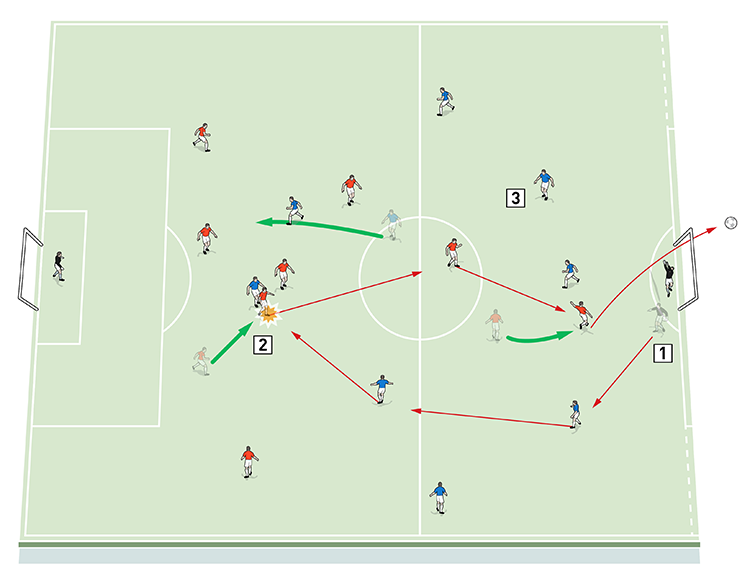
2. Here the reds win the ball and transition quickly to attack
3. The blues don’t transition to defence quickly enough and fail to stop the reds from creating a shooting opportunity
We tend to set up for this in 4-3-1 formation with full backs acting as wing backs. We can increase the challenge by allowing only 20 seconds for an attack before the coach will play a new ball to the opposition. This is particularly effective in the last five minutes of the session.
What are the key things to look out for?
In the transition from defence to attack, players need to be brave and aggressive when they win the ball. Expansive and ambitious attacking will stretch opponents and challenge the opposition’s transition to defence. As soon as the ball is won, teams need to create height, width and depth. Forward runs are necessary to provide support and teams need to identify the space available to attack and be able to spot where the opposition are disorganised. There is less of a rigidity needed with respect to the transition to attack and players are encouraged to express themselves.
In the transition from attack to defence, teams need to get compact instantly. Teams can vary how they do this and experimentation is to be encouraged, particularly in pre-season. During the season, an upcoming opponent may influence whether we aim to press aggressively when the ball is lost or whether all players drop instantly to become compact behind the ball.
Related Files
Editor's Picks
Using the goalkeeper in build-up play
Pressing principles
Intensive boxes drill with goals
Penetrating the final third
Creating and finishing
My philosophy
Pressing initiation
Compact team movement
Defensive organisation
Coaches' Testimonials

Alan Pardew

Arsène Wenger

Brendan Rodgers

Carlos Carvalhal

José Mourinho

Jürgen Klopp

Pep Guardiola

Roy Hodgson

Sir Alex Ferguson

Steven Gerrard
Coaches' Testimonials

Gerald Kearney, Downtown Las Vegas Soccer Club

Paul Butler, Florida, USA

Rick Shields, Springboro, USA

Tony Green, Pierrefonds Titans, Quebec, Canada
Join the world's leading coaches and managers and discover for yourself one of the best kept secrets in coaching. No other training tool on the planet is written or read by the calibre of names you’ll find in Elite Soccer.
In a recent survey 92% of subscribers said Elite Soccer makes them more confident, 89% said it makes them a more effective coach and 91% said it makes them more inspired.
Get Monthly Inspiration
All the latest techniques and approaches
Since 2010 Elite Soccer has given subscribers exclusive insight into the training ground practices of the world’s best coaches. Published in partnership with the League Managers Association we have unparalleled access to the leading lights in the English leagues, as well as a host of international managers.
Elite Soccer exclusively features sessions written by the coaches themselves. There are no observed sessions and no sessions “in the style of”, just first-hand advice delivered direct to you from the coach.
